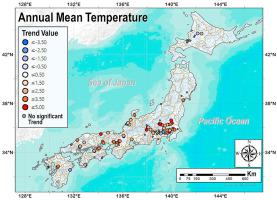Journal of Environmental Management ( IF 8.0 ) Pub Date : 2021-01-04 , DOI: 10.1016/j.jenvman.2020.111866 Feng Ye , Satoshi Kameyama

|
We analyzed freshwater temperature data from 1982 to 2016 throughout Japan to better understand how waters are warming in Japan. We used linear regression to determine the temperature change rate and Mann–Kendall tests to identify significant temporal trends in the annual maximum and mean temperatures. Among 11,240 monitoring sites screened, 159 with fewer missing values were selected for analysis. On the basis of this analysis, we identified and ranked the sites showing significant temporal increasing or decreasing trends for future management. At nearly half (42%) of the analyzed sites, the annual mean freshwater temperature was increasing; thus, in the future, adverse impacts from warm temperatures may increase in those aquatic ecosystems. The temperature change rate of fresh water was higher than that of air, indicating that the observed increases in freshwater temperature were not due to atmospheric warming only. Among individual sites, the annual maximum freshwater temperature change rate ranged from −1.27 to 1.91 °C/decade, and the annual mean rate ranged from −1.13 to 1.28 °C/decade. Few other studies have reported decreasing temperatures for fresh water. We expect our results will improve understanding of how freshwater temperatures are changing at a large scale, enhance understanding of human impacts on the aquatic environment, support effective management of ecosystems experiencing temperature changes, and help to minimize the loss of biodiversity over the next half century.
中文翻译:

1982-2016年日本全国淡水温度的长期时空变化
我们分析了1982年至2016年整个日本的淡水温度数据,以更好地了解日本的水如何变暖。我们使用线性回归确定温度变化率,并使用Mann-Kendall检验确定年最高温度和平均温度的重要时间趋势。在筛选的11,240个监测点中,选择了159个缺失值较少的监测点进行分析。在此分析的基础上,我们确定了地点并对其进行了排序,这些地点显示出明显的时间上增加或减少趋势,以便将来管理。在近一半(42%)的被分析地点,年平均淡水温度正在上升;因此,将来,温暖的温度对这些水生生态系统的不利影响可能会增加。淡水的温度变化率高于空气,这表明观察到的淡水温度升高不仅是由于大气变暖。在各个站点中,年度最高淡水温度变化率范围为−1.27至1.91°C /十年,并且年度平均速率范围为−1.13至1.28°C /十年。很少有其他研究报道淡水温度降低。我们希望我们的结果将增进人们对淡水温度如何大规模变化的理解,增进对人类对水生环境影响的理解,支持对经历温度变化的生态系统进行有效管理,并有助于在下半个世纪将生物多样性的损失降至最低。91°C /十年,年平均速率在-1.13至1.28°C /十年之间。很少有其他研究报道淡水温度降低。我们希望我们的结果将增进人们对淡水温度如何大规模变化的理解,增进对人类对水生环境影响的理解,支持对经历温度变化的生态系统进行有效管理,并有助于在下半个世纪将生物多样性的损失降至最低。91°C /十年,年平均速率在-1.13至1.28°C /十年之间。很少有其他研究报道淡水温度降低。我们希望我们的结果将增进人们对淡水温度如何大规模变化的理解,增进对人类对水生环境影响的理解,支持对经历温度变化的生态系统进行有效管理,并有助于在下半个世纪将生物多样性的损失降至最低。











































 京公网安备 11010802027423号
京公网安备 11010802027423号